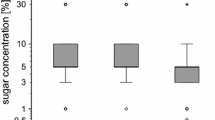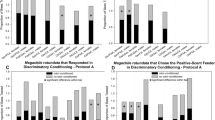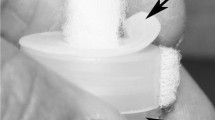Abstract
A recent study showed that the stingless bee Melipona quadrifasciata could learn to discriminate odors in a classical conditioning of proboscis extension response (PER). Here we used this protocol to investigate the ability of these bees to use olfactory information obtained within the colony in an experimental context: the PER paradigm. We compared their success in solving a classical differential conditioning depending on the previous olfactory experiences received inside the nest. We found that M. quadrifasciata bees are capable of transferring the food-odor information acquired in the colony to a differential conditioning in the PER paradigm. Bees attained higher discrimination levels when they had previously encountered the rewarded odor associated to food inside the hive. The increase in the discrimination levels, however, was in some cases unspecific to the odor used indicating a certain degree of generalization. The influence of the food scent offered at a field feeder 24 h before the classical conditioning could also be seen in the discrimination attained by the foragers in the PER setup, detecting the presence of long-term memory. Moreover, the improved performance of recruited bees in the PER paradigm suggests the occurrence of social learning of nectar scents inside the stingless bees’ hives.


Similar content being viewed by others
References
Aguilar I, Briceño D (2002) Sounds in Melipona costaricensis (Apidae: Meliponini): effect of sugar concentration and nectar source distance. Apidologie 33:375–388
Aguilar I, Fonseca A, Biesmeijer JC (2005) Recruitment and communication of food source location in three species of stingless bees (Hymenoptera, Apidae, Meliponini). Apidologie 36:313–324
Arenas A, Farina WM (2008) Age and rearing environment interact in the retention of early olfactory memories in honeybees. J Comp Physiol A 194:629–640
Arenas A, Fernández VM, Farina WM (2007) Floral odor learning within the hive affects honeybees’ foraging decisions. Naturwissenschafften 94:218–222
Arenas A, Fernández V, Farina WM (2008) Floral scents experienced within the colony affect long-term foraging preferences in honeybees. Apidologie (in press)
Balsam PD (1985) The function of context in learning and performances. In: Balsam PD, Tomie A (eds) Context and learning. L Erlbaum, New Jersey, pp 1–22
Bitterman ME, Menzel R, Fietz A, Schäfer S (1983) Classical conditioning of proboscis extension in honeybees (Apis mellifera). J Comp Psychol 97:107–119
Chabaud MA, Devaud JM, Pham-Delègue MH, Preat T, Kaiser L (2006) Olfactory conditioning of proboscis activity in Drosophila melanogaster. J Comp Physiol A 192:1335–1348
Chaffiol A, Laloi D, Pham-Delègue M (2005) Prior classical olfactory conditioning improves odour-cued flight orientation of honey bees in a wind tunnel. J Exp Biol 208:3731–3737
Dall SRX, Giraldeau LA, Olsson O, McNamara JM, Stephens DW (2005) Information and its use by animals in evolutionary ecology. TREE 20(4):187–193
Danchin E, Giraldeau LA, Valone TJ, Wagner RH (2004) Public information: from nosy neighbors to cultural evolution. Science 305:487–491
Dornhaus A, Chittka L (1999) Evolutionary origins of bee dances. Nature 401:38
Farina WM, Grüter C, Díaz PC (2005) Social learning of floral odours inside the honeybee hive. Proc R Soc B 272:1923–1928
Farina WM, Grüter C, Acosta L, Mc Cabe S (2007) Honeybees learn floral odors while receiving nectar from foragers within the hive. Naturwissenschaften 94:55–60
Frings H (1944) The loci of olfactory end-organs in the honeybee, Apis mellifera Linn. J Exp Zool 97:123–134
Gerber B, Geberzahn N, Hellstern F, Klein J, Kowalksy O, Wüstenberg D, Menzel R (1996) Honey bees transfer olfactory memories established during flower visits to a proboscis extension paradigm in the laboratory. Anim Behav 52:1079–1085
Gil M, De Marco RJ (2005) Olfactory learning by means of trophallaxis in Apis mellifera. J Exp Biol 208:671–680
Giurfa M (2003) Cognitive neuroethology: dissecting non-elemental learning in a honeybee brain. Curr Opin Neurobiol 13:726–735
Grüter C, Acosta LE, Farina WM (2006) Propagation of olfactory information within the honeybee hive. Behav Ecol Sociobiol 60:707–715
Grüter C, Balbuena MS, Farina WM (2008) Informational conflicts created by the waggle dance. Proc R Soc B 275:1321–1327
Heyes CM (1994) Social learning in animals: categories and mechanisms. Biol Rev 69:207–231
Hrncir M, Jarau S, Zucchi R, Barth FG (2000) Recruitment behavior in stingless bees, Melipona scutellaris and M quadrifasciata. II. Possible mechanisms of communication. Apidologie 31:93–113
Hrncir M, Jarau S, Zucchi R, Barth FG (2004) Thorax vibrations of a stingless bee (Melipona seminigra). I. No influence of visual flow. J Comp Physiol A 190:539–548
Jandt JM, Jeanne RL (2005) German Yellowjacket (Vespula germanica) Foragers use odors inside the nest to find carbohydrate food sources. Ethology 111:641–651
Jarau S, Hrncir M, Zucchi R, Barth FG (2000) Recruitment behavior in stingless bees, Melipona scutellaris and M. quadrifasciata. I. Foraging at food sources differing in direction and distance. Apidologie 31:81–91
Knudsen JT, Tollsten L, Bergström LG (1993) Floral scents. A checklist of volatile compounds isolated by head-space techniques. Phytochemistry 33:253–280
Laloi D, Pham-Delegue MH (2004) Bumble bees show asymmetrical discrimination between two odors in a classical conditioning procedure. J Insect Behav 17(3):385–396
Laloi D, Sandoz JC, Picard-Nizou AL, Pham-Delègue MH (1999) Olfactory conditioning of the proboscis extension reflex in the bumble bee Bombus terrestris. Ann Soc Entomol France 35:154–158
Leadbeater E, Chittka L (2007) Social learning in insects—from miniature brains to consensus building. Curr Biol 17:703–713
Lindauer M (1956) Über die Verständigung bei indischen Bienen. Z vergl Physiol 38:521–557
Lunney GH (1970) Using analysis of variance with dichotomous dependent variable: an empirical study. J Educ Meas 7(4):263–269
Mc Cabe SI, Hartfelder K, Santana WC, Farina WM (2007) Odor discrimination in classical conditioning of proboscis extension in two stingless bee species in comparison to Africanized honeybees. J Comp Physiol A 193:1089–1099
Menzel R (1999) Memory dynamics in the honeybee. J Comp Physiol A 185:323–340
Nieh JC (2004) Recruitment communication in stingless bees (Hymenoptera, Apidae, Meliponini). Apidologie 35:159–182
Rescorla RA, Durlach PJ, Grau JW (1985) Context learning in Pavlovian conditioning. In: Balsam PD, Tomie A (eds) Context and learning. L Erlbaum, New Jersey, pp 23–56
Roces F (1990) Olfactory conditioning during the recruitment process in leaf-cutting ants. Oecology 83:261–262
Sandoz JC, Laloi D, Odoux JF, Pham-Delègue MH (2000) Olfactory information transfer in the honeybee: compared efficiency of classical conditioning and early exposure. Anim Behav 59:1025–1034
Seeley T (1995) The wisdom of the hive. Harvard University Press, Cambridge
Slaa EJ, Cevaal A, Sommeijer MJ (1998) Floral constancy in Trigona stingless bees foraging on artificial flower patches: a comparative study. Apicult Res 37(3):191–198
Sokal RR, Rohlf FJ (1995) Biometry: the principles and practice of statistics in biological research, 3rd edn. WH Freeman and Co., New York
Takeda K (1961) Classical conditioned response in the honey bee. J Insect Physiol 6:168–179
Tomberlin JK, Rains GC, Allan SA, Sanford MR, Lewis WJ (2006) Associative learning of odor with food or blood-meal by Culex quinquefasciatus Say (Diptera: Culicidae). Naturwissenschaften 93(11):551–556
von Frisch K (1967) The dance language and orientation of bees. Harvard University Press, Cambridge
Wenner AM, Wells PH, Johnson DL (1969) Honey bee recruitment to food sources: olfaction or language? Science 164:84–86
Acknowledgments
This study was supported by funds from a CAPES-SECyT international exchange grant (071/04) to Klaus Hartfelder (Brazil) and WMF, and it was performed at the Instituto de Genética, Faculdade de Filosofia, Ciências e Letras de Ribeirão Preto, Universidade de São Paulo, Ribeirao Preto, SP, Brazil. We are deeply indebted to K. Hartfelder for his contributions to the development of the exchange work that allowed the performance of these experiments, to W. Santana for his technical assistance and to the staff of the Instituto de Genética to allow the development of this study. We also thank A. Arenas for valuable comments on an early version of this manuscript. This study was also supported by funds from ANPCyT (1155), UBACyT (X 077) and CONICET, to WMF. We declare that our experiments comply with the current laws of the country in which they were performed.
Author information
Authors and Affiliations
Corresponding author
Rights and permissions
About this article
Cite this article
Mc Cabe, S.I., Farina, W.M. Odor information transfer in the stingless bee Melipona quadrifasciata: effect of in-hive experiences on classical conditioning of proboscis extension. J Comp Physiol A 195, 113–122 (2009). https://doi.org/10.1007/s00359-008-0391-6
Received:
Revised:
Accepted:
Published:
Issue Date:
DOI: https://doi.org/10.1007/s00359-008-0391-6




